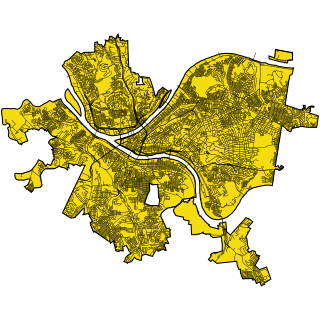Source:Four-corners-southeast
Douglas Naylor. "The four corners of Pittsburgh: Old timer of Buttermilk Hollow will 'talk 7 straight hours': Subterranean coal fire will destroy city some day, residents believe." Pittsburgh Press, Apr. 12, 1932, p. 17. Newspapers.com 146918248.
There's no need for Pittsburghers to go to far places of the world to find strange and interesting faces and stories. They can find them in the "Four Corners of their own home town. This is a story of the Southeast Corner. Tomorrow that of the Northeast Corner will be told.
AN EXPLORER of the Four Corners of the city will think he is approaching a smouldering Mt. Vesuvius when he drives down Mifflin Road into the valley nicknamed "Buttermilk Hollow" in the southeast corner.
This burning coal mine started in Mifflin Township four years ago. It is thought to be spreading under Pittsburgh today. There is a belief in "Buttermilk Hollow" that a corner of the city may collapse some day.
Residents blame the fire on Pittsburghers who did not confine their drinking to buttermilk. Dry days brought a demand for moonshine. Bootleggers moved into the abandoned mine and piped in gas and water from the city mains. They set the mine on fire and fled. That was four years ago.
The fire still is raging. Local coal miners believe it has spread at least 100 yards. The adjoining paving on Mifflin Road has sunk in two or three spots lately. On rainy days an immense amount of steam rises from the area, almost an acre, giving it a threatening appearance.
Two lives have been lost in the burning mine.
∗ ∗ ∗
A FAMOUS Old Timer of "Buttermilk Hollow" is George Best. He has the reputation in Lincoln Place of being able "to talk seven straight hours" on local history.
His most cherished relic of a fading past is a superb old sleigh of hickory and oak, made in Pittsburgh before the Civil War.
Best recalls his first visit to the city. He was five years old. It happened that a tribe of Indians arrived that day, coming in on the tops of the passenger coaches of a train.
Everybody swarmed down to the Union Station, including Mr. and Mrs. Best and their excited son.
When the tribe marched down the street, six abreast and 600 strong, the youngster strode along at the head of the procession.
"I kept looking up at the old chief and he kept smiling down at me," says Best. "I forgot about my parents and didn't know I had strayed away until we reached Allegheny City.
∗ ∗ ∗
"There used to be some good hunting down here in this valley," he continued. "Today there are only rabbits and pheasants, but when I was a little shaver there were gray squirrels and fox. I hunted with an old squirrel rifle with a 'hair trigger'."
Best remembers the day when all Lincoln Place was covered with solid timber, with a few small clearings.
"Allegheny white oak is the best oak in the world," he adds, sadly patting the sturdy framework of the sleigh, still in perfect condition. Best wants to take his three little grandchildren out riding next winter in the hand-made antique.
"In early days there were two stills near here," he recalled as he hitched up old Jerry, a faithful friends [sic] of many years.
"All the good people of the neighborhood used to slip down to these stills for a drink of tanglefoot. Afterwards they would go down into the bottom land and eat mint to kill the whisky on their breaths."